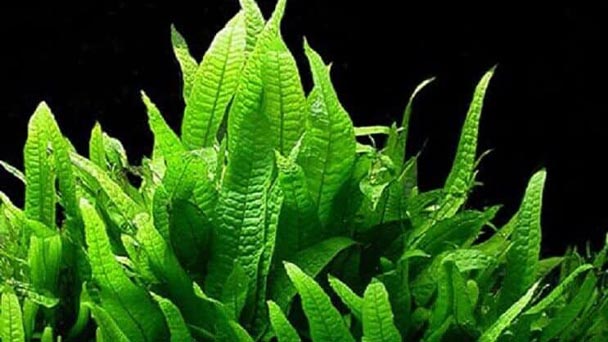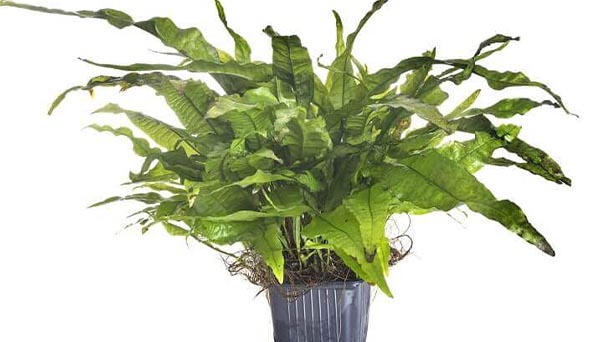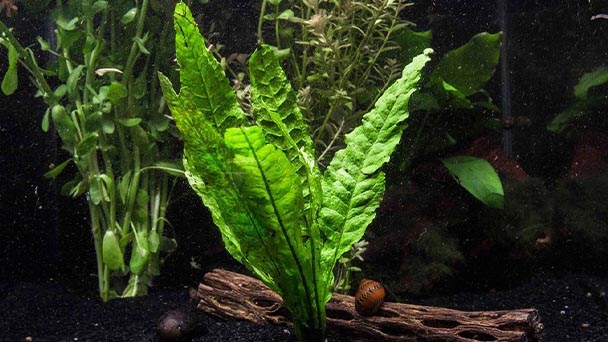Java Fern Profile
Written by Joy
Aug 30 2021

The Java Fern, scientifically famous as Microsorum pteropus, is a classic and very common plant belonging to an aquarium. Its delicate appearance adds a beautiful look to aquariums, which attracts tons of attention from many visitors. It's widely used as its slow growth, unique shape and easy care. It can be kept with a wide range of fish and doesn't require strict water parameters, which is the reason why it is so attractive to so many people. They are one of the easiest plants for beginners.


Java Fern morphological characteristics
Java Fern is a common green aquarium plant, which consists of two main components; rhizome and leaves. The rhizomes perform as an anchor, and are dark brown hair-like strings that attach themselves to many different surfaces. The leaves are very hardy and have a leathery texture in different shapes, from bushy to spiky. It comes in a variety of greens, from light to dark green. Especially the higher the lighting, the darker the green will be. Some mature leaves form a few black small circular bumps , and sometimes own a few black lines going through the leaves.Java Fern growth habit and growing environment and distribution
Like fish, aquatic plants thrive when the tank conditions match their natural conditions as closely as possible. In its natural climate, Java Fern prefers to grow along streams and is often found near running water. Filters and powerheads provide enough oxygen for these plants within the aquarium, and they do not need enough CO2.They can also be found in the jungle, where soft acidic water is sprayed on its leaves from streams and waterfalls. To meet these conditions, the requested pH is between 6.0 and 7.0 with a hardness of 3-8dGH. It is easy to keep such a plant and really doesn't need any special conditions to grow. It doesn't require high light or high nutrients, which is the reason why it's such a dream plant.
You don't need a fancy tank for it to grow. It will grow in the most simple of sit ups. The size for its living is flexible. It is not recommended that you put it in tanks tinier than this. It will grow in most lighting conditions. The most suitable conditions are subdued florescent or incandescent bulbs. And feeders should pay attention to the conditions that you offer. They will become brown and unhealthy if the lighting that you give is too strong.
Java Fern Care
Java Fern has rhizomes which shouldn't be buried. The plant will grow very slowly, or maintain its former look for a long time. Instead of burying it, you'll need to attach it to rocks or something similar, under which it refers. Rough surfaces make better surfaces than smoother ones. Anything like lava rock or driftwood will work perfectly. If the surface is too smooth, it will take a longer time to attach itself. A large piece of driftwood is more suitable to offer it to spread, however small pieces are also fine if possible.When we care for java fern, feeders should tie the roots using several fishing wires to your object. Black is the suitable color of thread to use as it is exactly the color of the roots. Some people tend to use rubber bands on occasions, however they will usually be visible from the exterior of your tank.
After a few weeks, the roots will have attached themselves to the surface of the places wherever you've attached them to. Once the roots are grown well, you can remove the ties. If you don't want to get the plant covered as it grows up.
Java Fern can grow quite large and has particularly wide leaves. It's therefore requested that you'd better plant it in the middle, or towards the back of the tank, in this way it will grow in a good appearance. Read More: Java Fern Care.
Latest Updated
- Benefits of Bugleweed - 7 Science-backed Health Benefits
- Bugleweed Dangers & Side Effects - Is It Poisonous?
- How to Plant Evergreen Trees - What You Should Know
- When to Plant Evergreens - Grow Guide for Evergreen Trees
- 12 Wonderful Evergreen Shrubs for Your Garden
- 12 Popular Evergreen Plants with Pictures for Beginners
- When And How To Prune A Lilac Bush Like a Pro
- How to Grow & Care for Lilac Vine (Hardenbergia Violacea)
- Japanese Lilac Tree (Syringa Reticulata) Care & Propagation Guide
- Shumard Oak Pros and Cons - What to Know
Popular Articles
- Winter maintenance of Antirrhinum Majus
- How to Grow Terminalia Mantaly Tree
- How to Grow and Care for Crossostephium Chinense
- How to grow Antirrhinum Majus in spring
- Peristeria Elata (Dove Orchid) Profile: Info & Care Guide
- Underwatered Snake Plant (Sansevieria Trifasciata) - Signs And How To Fix
- How to Care for Brazilian Jasmine Plant (Mandevilla Sanderi)
- How to Grow & Care for Graptopetalum Purple Delight in Summer
- Rosa Chinensis (China Rose): Plant Growing & Care Tips
- How to Care for Baby Sun Rose (Aptenia Cordifolia)